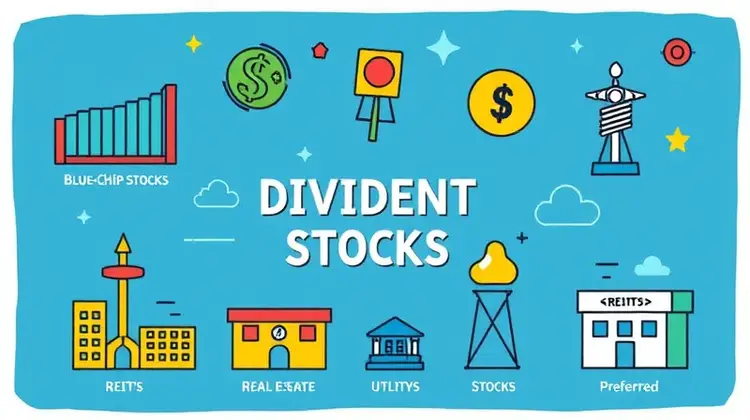Investing in dividend-paying stocks is a popular strategy for individuals looking to generate passive income. This investment approach not only allows investors to earn regular payouts from their investments but can also contribute to wealth accumulation over time. As companies distribute a portion of their earnings to shareholders, dividend investing offers both stability and growth, making it an attractive option for many.*
In this article, we will delve into the world of dividend investing, exploring essential concepts, strategies, and types of dividend stocks that can enhance your portfolio. Whether you are a seasoned investor or just starting your financial journey, understanding dividends is key to optimizing your investment efforts.
What Are Dividends?

Dividends are payments made by corporations to shareholders as a way to distribute a part of their earnings. These payments can come in various forms, including cash or additional shares of stock. Companies that pay dividends tend to have a stable earnings base and are often more established in their industry, reinforcing their financial health.
Dividends can be classified into two main types: regular and special dividends. Regular dividends are paid on a consistent basis, typically quarterly or annually, while special dividends are one-time payouts that may occur when a company experiences significant profits or decides to reward shareholders unexpectedly.
- A share of profits paid to shareholders
- Usually paid in cash or stock
- Reflect a company's profitability and financial status
Investors often seek dividend-paying stocks because they provide a steady income stream, especially in low-interest environments. Understanding dividends is crucial for building an effective investment strategy focusing on long-term wealth creation.
Why Invest in Dividend Stocks?

Investing in dividend stocks can be one of the smartest financial decisions you make. Unlike non-dividend-paying stocks, dividend stocks provide tangible returns that can help hedge against market volatility and inflation. As such, they appeal to a wide variety of investors, from retirees seeking stability to younger investors aiming for long-term growth.
1. Regular Income
One of the primary reasons investors are drawn to dividend stocks is the potential for generating a regular income. With consistent dividend payments, you can count on a reliable cash flow from your investments, which can be particularly beneficial in retirement when you may be relying solely on your investment portfolio for support.
Furthermore, dividends can provide a predictable income stream during uncertain economic conditions. When market prices fluctuate, dividend income can act as a stabilizing force, giving investors some peace of mind that they are still generating revenue from their holdings.
2. Potential for Capital Appreciation
While dividend income is attractive, many dividend stocks also offer the potential for capital appreciation. This means that in addition to receiving dividend payments, investors can benefit from the appreciation of the stock price over time. Many dividend-paying companies have strong, underlying fundamentals that can lead to stock price increases, providing investors with both regular income and growth in their investments.
Investors can compound their returns by reinvesting dividends back into purchasing more shares, thus increasing their overall investment value. This strategy can significantly amplify long-term growth, making dividend stocks a powerful tool for building wealth.
3. Tax Advantages
Investing in dividend stocks may provide tax advantages that can benefit your overall financial situation. In many jurisdictions, qualified dividends are taxed at a lower rate than ordinary income, making them an appealing option for investors. This can be particularly advantageous for those in higher tax brackets, whose income from regular salary could be taxed at rates higher than those for capital gains.
Additionally, investing in tax-advantaged accounts such as IRAs or 401(k)s can allow dividends to accumulate without immediate tax consequences, further enhancing the benefits of investing in dividend stocks.
4. Inflation Hedge
Dividends can serve as a protective measure against inflation. As the cost of living increases, so do the demands for higher income levels. Dividend-paying companies often increase their dividends over time, which can help offset the impact of inflation on your purchasing power. This ability to receive increasing income is particularly important for those planning for long-term financial stability, especially in retirement.
By investing in companies with a solid history of increasing dividends, you can create a reliable income stream that grows alongside inflation, ensuring that your purchasing power remains intact as you move forward financially.
How to Get Started with Dividend Investing

Getting started with dividend investing requires a few key steps. First, you need to educate yourself on the fundamentals of dividend investing, including the terminology and metrics used in evaluating dividend stocks. Understanding key performance indicators will help you select the right investments for your portfolio.
Secondly, you should consider your overall investment strategy. Decide whether you want to focus on building a portfolio of high-yield dividend stocks or if you prefer lower-yield stocks with a strong history of dividend growth. Your investment goals and risk tolerance will guide your approach.
- Research and understand dividend metrics
- Identify your income goals
- Select a diversified mix of dividend stocks
Once you have established your investment strategy, start building your portfolio by purchasing shares of dividend stocks that align with your goals. Additionally, consider using a dividend reinvestment plan (DRIP) to automatically reinvest dividends into purchasing more shares to further enhance your returns over time.
Types of Dividend Stocks

There are various types of dividend stocks available to investors. Understanding the different categories can help you make informed decisions on where to allocate your resources. Each category offers unique benefits and risks, making it essential to evaluate which types align with your investment strategy and financial goals.
Some of the most common types of dividend stocks include blue-chip stocks, real estate investment trusts (REITs), utility stocks, and preferred stocks. Each of these categories has specific characteristics that can enhance your overall portfolio.
1. Blue-Chip Stocks
Blue-chip stocks are shares of large, well-established companies that have a reputation for reliability and strong financial performance. These companies typically have a long history of paying dividends and are considered safe investments, especially during economic downturns. Their size and stability often allow them to weather market fluctuations better than smaller firms.
Investing in blue-chip stocks offers several advantages. They have a strong track record of increasing dividends, making them appealing for income-focused investors. Moreover, their ability to reinvest profits into the business often leads to capital appreciation over time, positioning blue-chip stocks as a solid choice for long-term investment growth.
Some well-known examples of blue-chip stocks include companies in sectors like technology, healthcare, and consumer goods, such as Apple, Johnson & Johnson, and Procter & Gamble. The stability and dividend-paying history of these companies make them a go-to option for conservative investors looking for reliable income.
2. Real Estate Investment Trusts (REITs)
Real Estate Investment Trusts (REITs) are companies that own and manage income-generating real estate properties. They are required by tax laws to distribute at least 90% of their taxable income to shareholders in the form of dividends, making them an attractive option for income-seeking investors. REITs typically pay higher dividends than traditional stocks because of this distribution requirement.
Investing in REITs not only provides a steady stream of income through dividends but also offers diversification benefits in an investment portfolio. Real estate often behaves differently than traditional stocks and bonds, which can help mitigate risk during market volatility. Additionally, as real estate values increase over time, so may the dividends paid by these investment vehicles, providing potential for both income and capital appreciation.
With various sectors of the REIT market available, such as residential, commercial, and industrial, investors can tailor their investments to align with their goals and risk tolerance.
3. Utility Stocks
Utility stocks are another popular choice for dividend investors. These companies provide essential services such as water, electricity, and natural gas to consumers, allowing them to maintain steady revenue streams, even in poor economic conditions. The predictability and stability of their cash flows often lead to consistent dividend payments, making utility stocks a safe bet for income-focused investors.
Due to their mission of providing essential services, utility companies often operate with regulated pricing structures, which help ensure revenue stability. This also means that utility stocks may offer lower volatility compared to traditional stocks, making them an attractive option for risk-averse investors. Consistent dividend payments combined with low volatility makes utilities a reliable source of income.
Utility stocks typically yield higher dividends relative to other sectors, with many of these companies having a long record of paying and even increasing their dividends. This combination of stability, predictability, and income makes utility stocks a mainstay in the portfolios of conservative investors.
4. Preferred Stocks
Preferred stocks are hybrid securities that exhibit characteristics of both common stocks and bonds. While holders of preferred stocks do not have voting rights like common stockholders, they enjoy priority over common stockholders when it comes to dividend payments. This often results in preferred stocks delivering higher dividend yields compared to common stocks, making them an appealing choice for income-focused investors.
Preferred stocks can vary significantly in their characteristics, including fixed dividends, potential for dividend growth, and liquidity. Their fixed dividend payments can provide predictable income, similar to traditional bonds, making them a hybrid alternative for those looking to diversify their income sources while still retaining some equity exposure.
Investors should note that preferred stocks can be sensitive to interest rate fluctuations, which may impact their market prices. Nevertheless, preferred stocks remain a valuable component of a diversified dividend investing strategy, particularly for individuals seeking higher yields within the equity space.
Key Metrics to Evaluate Dividend Stocks

When selecting dividend stocks, it's essential to evaluate a set of key performance metrics to ensure you're making informed investment decisions. Here are four critical metrics that every dividend investor should consider when analyzing potential stocks for their portfolio.
By understanding these metrics, you can gauge the sustainability of a company's dividends, learn how much you can expect to earn, and determine the overall financial health of the organization.
1. Dividend Yield
Dividend yield is one of the primary metrics used to assess dividend stocks. It is calculated by dividing the annual dividend payment by the current stock price. The resulting percentage indicates the return an investor can expect in the form of dividends relative to their investment. A higher yield often attracts income-focused investors, but it’s crucial to consider the sustainability of the yield alongside other factors.
While a high dividend yield may seem appealing, it could also indicate potential issues within the company, such as declining share prices or reduced profitability, which might lead to unsustainable dividends in the long run. Therefore, it’s essential to look beyond just the yield and assess whether the company can maintain or grow its dividend payments over time.
Investors should also compare dividend yields against peers and industry averages to get a better sense of whether the yield is attractive given the company's risk profile.
2. Dividend Payout Ratio
The dividend payout ratio is another critical metric used by investors to evaluate dividend sustainability. This ratio is calculated by dividing the annual dividends paid by the company's earnings. It shows the proportion of earnings that a company returns to its shareholders in the form of dividends. A lower payout ratio indicates a safer dividend, whereas a higher ratio may raise red flags regarding potential dividend cuts.
Investors typically view a payout ratio below 60% as healthy, suggesting that a company can maintain its dividends while continuing to reinvest in growth opportunities. However, some mature companies may operate with higher payout ratios, reflecting their established business models and stable cash flows. Understanding a company’s specific context is essential when interpreting payout ratios.
When assessing stocks, consider their historical payout ratios alongside their expected future earnings growth. A steadily increasing payout ratio paired with robust company growth is generally a good sign for investors seeking dependable income.
3. Dividend Growth Rate
The dividend growth rate measures how consistently and rapidly a company has been able to increase its dividend payments over time. This rate is typically expressed as a percentage and helps investors gauge the company’s ability to grow its dividend assets. A higher growth rate is often an attractive feature for investors who prioritize income growth and long-term stability.
Investors usually look for companies with a history of consistently raising dividends, commonly referred to as “dividend aristocrats.” These firms demonstrate a commitment to returning value to shareholders, suggesting robust financial health and management discipline. As dividends grow, so does the investor's income potential, which can provide substantial advantages, particularly in retirement.
Evaluating the dividend growth rate alongside earnings growth and other financial metrics can provide a fuller picture of a company’s health and outlook. By prioritizing companies with strong growth rates, investors can enhance their portfolios' income potential and long-term viability.
4. Financial Stability
Financial stability is a critical component of evaluating dividend stocks. Assessing a company’s overall financial health via various metrics, such as debt-to-equity ratio, return on equity, and cash flow analysis, can provide insight into its ability to sustain dividend payments over time.
Investors should carefully analyze financial statements and ratios to understand potential risks associated with their dividend investments. Companies with high levels of debt may face challenges during economic downturns, leading to increased probabilities of dividend cuts. Attention to consistent revenue and earnings growth can help mitigate these risks and ensure long-term dividend sustainability.
- Debt-to-Equity Ratio
- Return on Equity
- Cash Flow Analysis
By scrutinizing the financial stability of dividend stocks, investors can build a more resilient and reliable investment portfolio that stands the test of market volatility.
Risk Factors to Consider

While dividend investing has compelling advantages, it is crucial to be aware of the risks involved. Market fluctuations and economic downturns can negatively impact companies' ability to pay dividends, and factors such as increased debt or falling revenues can lead to dividend cuts. Investors need to maintain diligence in monitoring their investments to assess financial stability continually.
Additionally, diversifying your portfolio can help mitigate risks associated with dividend investing. Relying heavily on a few stocks or a single sector can expose you to excessive risk. Spread your investments across various companies and sectors to reduce the impact of any single poor performer.
- Economic downturns and market fluctuations
- Relying too heavily on a single sector or stock
- Interest rate changes affecting stock prices
Ultimately, understanding and managing these risks is critical to building a successful dividend investing strategy.
Conclusion

Dividend investing can be a powerful strategy for generating passive income and accumulating wealth over time. By focusing on sustainable dividend-paying stocks, investors can create a steady income stream while benefiting from capital appreciation.
However, it is essential to conduct thorough research on dividend stocks, evaluating their financial health and the sustainability of their dividends. By understanding key metrics and actively managing risks, you can optimize your dividend investing strategy for long-term success.














